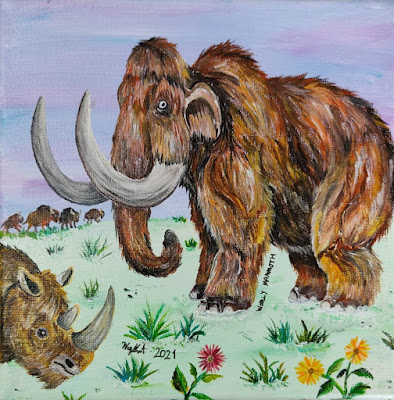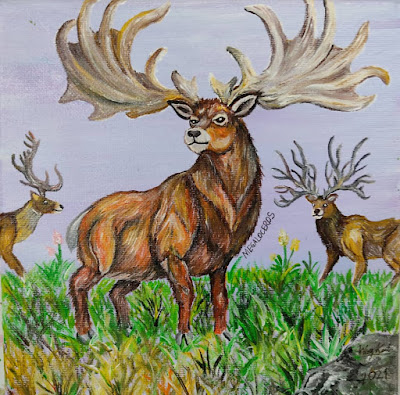Collection: Cenozoic Combo
CENOZOIC COMBO
The disappearance of the non-avian dinosaurs had left ecological roles wide open for a surviving lineage of animals to evolve and occupy: the mammals. Although birds had stepped into the roles earlier in the next stage of mammal evolution, mammals took over at the beginning of the Cenozoic Era, also known by scientists to be the golden age of mammals. Throughout the Cenozoic, mammals have undergone diversification and development to fill in the roles and become one of Earth's most dominant families of vertebrates on land.
Cenozoic Combo, acrylic on canvas, 2021. Set of 9, each piece 8" X 8"
Woolly Mammoth
Woolly Mammoth, acrylic on canvas, 2021. 8" X 8"
The woolly mammoth (Mammuthus primigenius) is the most iconic animal from the Ice Age. It was the size of a fully-grown African elephant. During the winter season, mammoths keep a thick coat of long fur to withstand the freezing climate of the Pleistocene ice ages. Besides mammoths, other large ice age mammals such as bison and woolly rhinoceros also evolved these characteristics. These large mammals went into decline when the last ice age ended at the very end of the Pleistocene, and eventually they became extinct due to inability to adapt to climate change and overhunting by ancient humans. The last mammoths on Earth disappeared around 4000 years ago.
Smilodon
Smilodon populator, acrylic on canvas, 2021. 8" X 8"
Smilodon is the most famous member of a family of cats known as the saber-toothed cats. They lived in North and South America during the Pleistocene, and originated in North America before they moved south via the Central American land bridge. Smilodon sported a pair of over 20-centimeter long canine teeth, which earned them the "saber-tooth" nickname. As a top predator, they hunted large mammals, and became extinct around the same time as most of the large mammals at the end of the last ice age. The picture depicts a South American Smilodon alongside other animals from the continent including Macrauchenia (left), a herbivorous, llama-like mammal with an enlarged snout, and Phorusrhacos (right), a member of a family of large, flightless carnivorous birds called "terror birds".
Megatherium
Giant Ground Sloths, acrylic on canvas, 2021. 8" X 8"
Giant ground sloths are closely related to their modern, tree-living cousins and lived in the Americas during the latter half of the Cenozoic through the Quaternary period. The last ground sloths to appear were very large, the largest species being Megatherium (meaning "big beast") from the Pleistocene of South America. Megatherium grew to the size of an elephant and lived on a herbivorous diet of mostly tree leaves. The picture also depicts a smaller species of giant ground sloth named Glossotherium (meaning "tongue beast"). Giant ground sloths became extinct at the end of the last ice age, when the large mammals began to decline.
Megaloceros
Megaloceros, acrylic on canvas, 2021. 8" X 8"
Megaloceros (meaning "large horn") was one of the largest species of deer. There are several species of Megaloceros, and the most well-known and largest species is Megaloceros giganteus, which was popularly known as the "Irish elk". Despite the name, Megaloceros were not closely related to modern elk but to the fallow deer. Each of the antlers of this deer could grow to the length of a person's height. Like most large mammals of the ice age, Megaloceros became extinct due to climate change and overhunting, and the species disappeared around 7000 years ago. In the picture, a male individual shares the grassland with another two species of ice age deer, the Praemegaceros (left) and the Eucladoceros (meaning "well-branched antlers", right).
Doedicurus
Doedicurus, acrylic on canvas, 2021. 8" X 8"
Doedicurus (meaning "pestle tail") is a member of a group of mammals called glyptodonts, which are relatives of the modern armadillo. The size of a modern car, Doedicurus had a spiky, bony club at the end of its tail which it used to defend against predators. This heavily-armed herbivore roamed South America during the Pleistocene and disappeared along with the other ice age mammals at the end of the last ice age. It was hunted by early human settlers in South America for its shell which was used as a shelter during harsh weather. The birds flying over the animal in the painting are Teratornis, large relatives of condors.
Uintatherium
Uintatherium, acrylic on canvas, 2021. 8" X 8"
The Eocene period (56 to 33 million years ago) marked an early step in mammal evolution. One of the largest mammals known from the early Eocene is Uintatherium, a large herbivore with bony knobs on its skull. The size of today's rhinoceros, Uintatherium had a pair of large canine teeth, which it may have used to feed on aquatic plants. The function of the bony knobs on Uintatherium's head was either for defense or display, but the exact function is still unknown to science. The smaller mammals below the Uintatherium in the painting is Hyracotherium, one of the earliest forms of horses. The first horses to evolve were only the size of cats. The mammal on the tree branch is Notharctus (meaning "false bear"), an early member of the primate family. Bats also evolved in the Eocene, and the species in the painting is Icaronycteris, the earliest known definitive bat. Although mammals have already begun to occupy the role of alpha predators in this period, birds have already filled the top of the food chain. The large bird on the right is Gastornis, a bird which was thought to have been an apex predator.
Andrewsarchus
Andrewsarchus, acrylic on canvas, 2021. 8" X 8"
Indricotherium/Paraceratherium
Indricotherium, acrylic on canvas, 2021. 8" X 8"
Gigantopithecus
Gigantopithecus, acrylic on canvas, 2021. 8" X 8"
Gigantopithecus (meaning "giant ape) was thought to be the largest known ape. It lived in southern China and Vietnam during the Pleistocene. It was believed to grow to twice the size of a modern gorilla, and studies on its fossils show that it was closely related to modern orangutans. The teeth of Gigantopithecus suggest that it lived a herbivorous lifestyle, feeding on leaves, bamboo and plants. This ape is believed to have disappeared around 300,000 years ago, caused by habitat loss and overspecialization.












Comments
Post a Comment